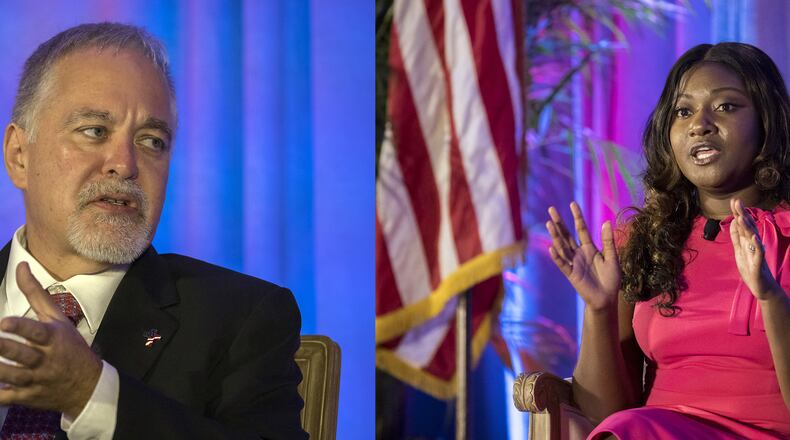Alisha Thomas Searcy called Georgia State School Superintendent Richard Woods an ineffective leader while he pointed to signs of success and policy changes he’s put in place as reasons that voters should give him another four years rather than elect her.
Woods, a Republican, faced Searcy, a Democrat, for the first time Monday during the Atlanta Press Club’s Loudermilk-Young debate series.
The pair have fielded questions in prior political forums, but this was the first true debate where they could fire away at each other directly. The 30-minute affair got personal, particularly as Searcy, 44, repeatedly said that she has three children and noted that Woods, 60, has none, suggesting that as a mother, she has a better grasp of issues like school safety.
Searcy painted a picture of an educational system in decline while an ineffectual Woods watched, noting that a minority of third graders are reading proficiently. (Just over a third scored proficient or better on their English Milestones tests last spring.)
Woods noted a rising graduation rate and college admissions test scores that beat the nation’s, and he pointed to incremental policy changes while in office.
They clashed on partisan issues that the superintendent has little control over, like whether to arm teachers or censor books and discussions about race. Searcy attacked Woods for defending Republican positions on those policies, saying they undermined teachers.
Woods fought back by attacking her support for teacher accountability legislation while a lawmaker.
They agreed on one fundamental issue sure to engage a key voting bloc: Teachers should get more pay.
The debate was fundamentally about each candidate’s fitness for the job.
A former state representative from Cobb County, Searcy went on to lead a small charter school network in DeKalb and Gwinnett counties and is now an educational consultant.
“I am the only candidate in this race who’s actually led schools before,” said Searcy, who claimed Woods has done “too little, too late.”
Woods said he has improved outcomes by reducing distractions for teachers. “I have been very supportive from day one of teachers and making sure that they have the time to teach,” he said.
Woods hammered away at Searcy’s policy positions. While in the General Assembly from 2003 through 2014, she “did nothing to ... have a positive impact on education,” he said. Instead, she backed legislation that increased the scrutiny of teachers, something Woods said he’s been dialing back during his eight years in office.
Teachers were going to have to undergo six observations — classroom visits by an administrator — a year, regardless of their level of experience, due to a law she helped pass, he said.
“I can tell you as an administrator, but especially as the only person who’s been a teacher on this stage, that was a complete waste of time,” said Woods, who taught high school social studies in Irwin County before moving into the administration ranks, first as an elementary school principal.
Woods was elected state superintendent in 2014. Searcy also ran for the office that year but didn’t secure the Democratic nomination. Both swept their party primary last spring, winning all 159 counties.
Searcy has been a lightning rod within her own party, though, due to her support of charter schools and private school scholarships funded by tax credits. Stacey Abrams and other Democratic candidates have appeared in photographs without Searcy, prompting her to ask publicly why she has been “ostracized and excluded.”
Woods, meanwhile, has found an ally in fellow Republican Gov. Brian Kemp. They collaborated on increasing teacher pay and on reducing standardized testing.
The winner will lead the Georgia Department of Education, which is responsible for a third of the state budget. The agency distributes state and federal funding to schools while monitoring their academic performance and their compliance with laws and regulations.
The state superintendent has a limited policymaking role but can influence it by shaping public opinion, advising lawmakers and forging alliances with political leaders.
About the Author
Keep Reading
The Latest
Featured


